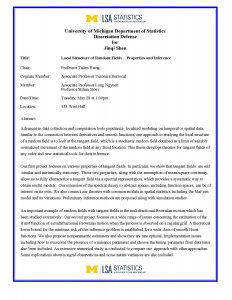Presented By: Department of Statistics Dissertation Defenses
Dissertation Defense: Local Structure of Random Fields - Properties and Inference
Jinqi Shen

Advances in data collection and computation tools popularize localized modeling on temporal or spatial data. Similar to the connection between derivatives and smooth functions, one approach to studying the local structure of a random field is to look at the tangent field, which is a stochastic random field obtained as a limit of suitably normalized increment of the random field at any fixed location. This thesis develops theories for tangent fields of any order and new statistical tools for their inference.
Our first project focuses on various properties of tangent fields. In particular, we show that tangent fields are self-similar and intrinsically stationary. Those two properties, along with the assumption of mean-square continuity, allow us to fully characterize a tangent field via a spectral representation, which provides a systematic way to obtain useful models. Our extension of the spectral theory to abstract spaces, including function spaces, can be of interest on its own. We also connect our theories with common models in spatial statistics including the Mat\'ern model and its variations. Preliminary inference methods are proposed along with simulation studies.
An important example of random fields with tangent fields is the multifractional Brownian motion which has been studied extensively. Our second project focuses on a wide range of issues concerning the estimation of the Hurst function of a multifractional Brownian motion when the process is observed on a regular grid. A theoretical lower bound for the minimax risk of this inference problem is established for a wide class of smooth Hurst functions. We also propose nonparametric estimators and show they are rate optimal. Implementation issues including how to overcome the presence of a nuisance parameter and choose the tuning parameter from data have also been included. An extensive numerical study is conducted to compare our approach with other approaches. Some explorations about nongrid observations and nonconstant variances are also included.
Our first project focuses on various properties of tangent fields. In particular, we show that tangent fields are self-similar and intrinsically stationary. Those two properties, along with the assumption of mean-square continuity, allow us to fully characterize a tangent field via a spectral representation, which provides a systematic way to obtain useful models. Our extension of the spectral theory to abstract spaces, including function spaces, can be of interest on its own. We also connect our theories with common models in spatial statistics including the Mat\'ern model and its variations. Preliminary inference methods are proposed along with simulation studies.
An important example of random fields with tangent fields is the multifractional Brownian motion which has been studied extensively. Our second project focuses on a wide range of issues concerning the estimation of the Hurst function of a multifractional Brownian motion when the process is observed on a regular grid. A theoretical lower bound for the minimax risk of this inference problem is established for a wide class of smooth Hurst functions. We also propose nonparametric estimators and show they are rate optimal. Implementation issues including how to overcome the presence of a nuisance parameter and choose the tuning parameter from data have also been included. An extensive numerical study is conducted to compare our approach with other approaches. Some explorations about nongrid observations and nonconstant variances are also included.